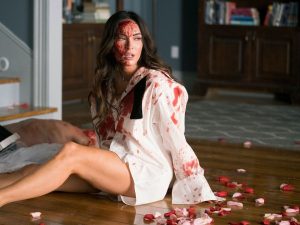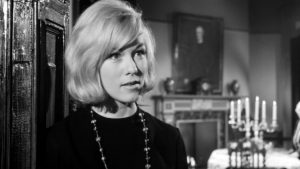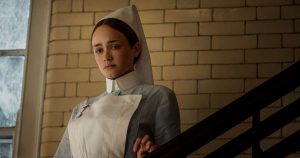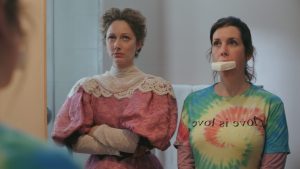After bursting onto the scene with 2007’s Transformers, Megan Fox actively sought, by way of several intriguing roles, to subvert the sexpot image foisted upon her by director Michael Bay and the fetishistic framing of that movie and its sequels. Most notable among these efforts was undeniably Jennifer’s Body, a feminist horror comedy written by Diablo Cody and directed by Karyn Kusama, about a demonically possessed high school girl who racks up a high male body count. A modest box office performer at the time of its 2009 release, the movie has enjoyed a critical reappraisal in ensuing years. Whatever one makes of the film itself, though, Fox’s performance certainly showed that she was much more than the empty vessel that knee-jerk detractors might have assumed.

A decidedly more straightforward genre offering, Till Death features Fox as a woman chained to a body at a frozen lake house, grappling with unforgiving elements and ultimately pursued by killers. In tackling the role of an unhappy wife, there would seem to be the chance for Fox (recently divorced in real life) to channel some pent-up offscreen energy and serve it back up in a nuanced and surprisingly emotional way, not unlike the manner in which Jason Sudeikis has tackled the title role in Ted Lasso. While that element doesn’t really manifest, Till Death still serves as Fox’s best starring role in years.
Emma (Fox) is a young Manhattanite with a lover (Aml Ameen) on the side, but still stuck under the thumb of her arrogant and controlling lawyer husband, Mark (Eoin Macken). After she’s broken off her affair, surprise celebrations for the couple’s 11th anniversary unfold at a remote cabin, husband and wife cautiously circling one another in an emotional stalemate that mirrors the wintry weather outside. Emma wakes up the next morning to find herself handcuffed to her dead husband, and the house shrewdly stripped of any sharp or otherwise helpful objects which might assist her in extricating herself from this situation. Unexpected guests soon arrive, and Emma must scramble and her wits about her if she’s to survive.
The death-trap sub-genre is a rich one (see the recent Escape Room movies), and Till Death tweaks that by presenting an engaging and fairly inventive recombinant packaging of domestic menace movies like Sleeping With the Enemy and stranded-alone thrillers like The Shallows. Feature debut director S.K. Dale exhibits a solid instinct for framing and pacing, and Fox rather capably ratchets up her character’s levels of distress. The end result stands as a quite fine genre offering, even if it also feels like at least a little bit of a missed opportunity in terms of what could have been brought to bear on the material as a more racked-focus character study. The film’s Blu-ray presentation features a crisp 2.35:1 widescreen transfer, alongside a 5.1 DTS-HD audio track with a solid amount of dynamic range, even if the dialogue mix is a bit low. A handful of trailers and a six-and-a-half-minute making-of featurette comprise the bonus features, the latter including behind-the-scenes footage and brief interview snippets from Fox, Dale, and others dutifully alighting on topics ranging from the movie’s location shoot to real-life stories of battered women.
There are any number of filmmakers known for endless tinkering on their own works, and very high on that list (though certainly slotted below George Lucas) would be Francis Ford Coppola. In the case of his directorial debut Dementia 13, though, a compelling case can be made for such revisitation. A slice of gothic horror made on a shoestring budget in 1963 for producer Roger Corman, the movie is a somewhat thinly drawn riff on Psycho and Homicidal which nonetheless features rich evidence of both plus-size technical ambition and execution, and is thus a highly welcome home video entry in its newly restored collector’s edition director’s cut on Blu-ray.

Originally presented as the bottom half of a double bill with Corman’s Ray Milland-starring X: The Man With X-Ray Eyes, Dementia 13 centers on Louise (Luana Anders), an American-born woman whose fiancé John (Peter Read) passes away of a heart attack while they are out one night alone in a rowboat. Having been told that his death before his mother’s voids any claim she might have to his sizable inheritance, Louise dumps his body overboard and travels to her significant other’s native Ireland, where she schemes to ingratiate herself with her in-laws. It’s an intriguing brood, anchored by matriarch Lady Haloran (Eithne Dunne), but also featuring youngest sibling Billy (Bart Patton) and his hotheaded older brother Richard (William Campbell), who wants to wed Kane (Mary Mitchel), another American blonde. Vague domestic tragedy slowly comes into sharper focus, and a traumatic incident leaves Lady Haloran in a weakened state. As Dr. Justin Caleb (Patrick Magee), the family physician who sort of shadow-doubles as an interlocutor and investigator of the movie’s core mystery, tends to Lady Haloran, Louise preys upon her superstitious nature, setting off a tripwire of with deadly consequences.
Presented on Blu-ray in 1.78:1 widescreen with English mono DTS-HD and English 5.1 DTS-HD master audio tracks alongside optional English and Spanish subtitles, the Vestron Video Collector’s Edition release of Dementia 13 comes attractively packaged with a complementary cardboard slipcover, and also includes a digital copy of the film. The 1080p high definition transfer is superb, giving rich atmospheric depth to the movie’s black-and-white cinematography. In addition to chapter stops, bonus features include a surprisingly brief introduction to the movie by Coppola, as well as a William Castle-type prologue featuring a supposed psychiatrist administering a “Dementia 13 Test” to determine the mental fitness of prospective viewers. Used by Corman to pad out the running time of the movie, Coppola rather notoriously hated this segment (actually separately directed by Monte Hellman), but it stands as presented here as an amusing curio.
The collectible punching power of this release, though, far and away comes by way of its feature-length audio commentary track from Coppola. While not without some pregnant pauses (particularly as it gets deeper into its running time), this track is as warm and informative a guided tour of a master filmmaker’s early career as one could want — complete with both self-deprecation and an appropriate critical eye. It opens with an explanation of Corman’s favored modus operandi — squeezing budgets and using the surplus to fund side productions. Dementia 13 was thus born as an offshoot of The Young Racers, a film on which Coppola was serving as a sound man. Pitching Corman on the commerciality of his idea for a psychological horror film (and specifically a salacious scene in its center), Coppola received his blessing — as well as Campbell and Magee, stars of the aforementioned movie. Tapping longtime Corman key grip Charles Hanawalt to serve as cinematographer, Coppola stayed behind in Ireland and spent his evenings slamming out a screenplay that suitably fleshed out his outlined narrative, all while also in production, shooting nine days in a studio and an additional seven days or so on location, near Howth Castle.
Coppola speaks of additions demanded by an angry Corman (trimmed here) after he saw the finished product, but with fondness for the total freedom he had in shooting Dementia 13. He also shares incredible anecdotes about his cast (Magee was, it seems, a legendary alcoholic whose binge drinking led to him repeatedly waking up Coppola by falling down stairs in the middle of the night), with a tone that is more disarming than gossipy. Some of these reminiscences take on an especially affecting bent, too, as when Coppola notes that the adult actors seemed “positively elderly at the time, but actually young now.” The legendary director is honest about the many challenges he faced (“It was harder than I expected,” he says), and says that his aversion to too much dialogue was born of his experience on this movie. One of the more interesting stories he shares is in asking his father Carmine to contribute a score to the movie, but his dad refusing unless he could travel abroad and conduct the orchestra recording it. Knowing Corman would not allow that, and lacking the funds, Coppola instead turned to Ronald Stein, but still holds a certain wistfulness in his heart about the experience.

A richly atmospheric 1970s-set supernatural horror story which grounds itself in recognizable, character-based aguish, uncertainty, and fear, The Power is a movie which first lands as a well-made calling-card effort, before the cumulative impact of its technical efficiency and narrative intrigue deepens into something a bit more lastingly memorable. The feature debut of writer-director Corinna Faith, the film tells the tale of a nurse trainee, Val (Rose Williams), who arrives for her first day of work at a rundown East London hospital just as rolling electrical blackouts — the fallout from striking miners — are set to sweep the country. With most of the staff and patients evacuated to a nearby facility, Val is tabbed to work the night shift. When mysterious smells and sounds give way to more corporeal threats, Val must grapple with inner demons from her own traumatic past as she also confronts a menacing, malevolent energy with aims to destroy everything around her.
There’s an elegance to The Power‘s construction, and its writing is, at least thematically, enough to spawn several academic theses in the feminist horror realm. If there’s a bit of thinness to the character of Val, it’s ably fleshed out by Williams, who delivers a tightly controlled, mesmerizing turn. Faith, too, oversees a well-marshaled technical team, crafting an eerie tone and sustaining it throughout with the type of considerable aplomb which leaves one eager to see what she’ll do next. Presented in a 2.35:1 widescreen transfer free of any artifacting or color bleed, and featuring solid black levels, The Power comes with a Dolby digital 5.1 audio track, and optional English SDH and Spanish subtitles. Bonus features consist of an engaging feature-length audio track featuring Faith, Williams, and cinematographer Laura Bellingham, as well as a behind-the-scenes photo gallery.
Offering up a decidedly different spin on supernatural interaction than The Power is the comedy Lady of the Manor, the feature directorial debut of actor Justin Long and his younger brother Christian. A simply premised, smartly constructed, and well cast laffer that makes effective use of a couple core settings, this movie is a great showcase for its two female leads, Melanie Lynskey and Judy Greer, as well as a smile-inducing reminder that (for those who have for some reason forgotten about MacGruber) Ryan Phillippe is a top-shelf comedic weapon, just waiting to be more consistently deployed.

After a cold open establishes the murder of Lady Wadsworth (Greer) in the 1870s, Lady of the Manor pivots to the present day. Hannah (Lynskey) is an underachieving loafer who works as a marijuana delivery driver, but loses her job after she gets arrested in a (very funny) To Catch a Predator-style sting operation. As fate would have it, though, Hannah crosses paths with Tanner (Phillippe), the preppy, horned-up scion of a wealthy Savannah family who owns the Wadsworth mansion where so many years ago Greer’s character met her demise, and operates it as a museum. Having been romantically spurned by the female docent there, Tanner fires her, and impulsively hires Hannah for the same position. It’s there that the unqualified, foul-mouthed Hannah, after botching a tour in front of college professor Max (Long) and some of his students, meets the ghost of Lady Wadsworth. They clash at first, but when Hannah discovers the present-day Wadsworths have retained ownership of the estate through duplicitous and possibly felonious means, she makes a pact to help Lady Wadsworth while also submitting to a bit of personal refinement.
There’s a small social justice subplot here — about the historically unheralded contributions of minority groups, and appropriation of what they are often owed — that makes the movie’s ultimate resting place quite obvious. But the Longs come up with enough pleasing scenarios to keep Lady of the Manor moving at a rewarding pace. Its humor lands somewhere between juvenile and unsophisticated, but its script is structurally solid, and the interplay between characters allows consistently rich seams of exasperation with one another for its actors to explore (the only exception is a mostly wasted Luis Guzman, who appears as a bartender). The film’s performances are delightful to boot. Lynskey gets a chance to cut lose, and portray the type of socially arrested character it would be easy to envision Seth Rogen playing, while Greer ably locates various pressure points in her uptight high society character, and trades in an amusing range of reactions of piqued irritation.
The film’s Blu-ray release comes with a complementary cardboard slipcover, with the film presented in 1080p in 1.85:1 widescreen, along with a DTS HD 5.1 master audio track that adequately serves the straightforward, dialogue-driven needs of the story. A hearty selection of supplemental anchors the release, including five minutes of bloopers and outtakes (Phillippe gets to flex with a lot of different one-liner riffs, while Greer pulls faces and mock-books some airline travel on a library location shoot computer), and 17 deleted scenes. A 10-minute making-of featurette, meanwhile, makes effective use of its time, with the cast and crew talking about production, as well as the Longs talking about the movie being spun off from a different original idea of a comedic version of Psycho, and writing the script in seven days.
The strange and brutal November 1974 shotgun murders, by Ronald DeFeo, Jr., of his parents and four siblings provided the inspiration for both the book The Amityville Horror and a 1979 film of the same name. Since then, the moniker “Amityville” has served as a type of freeform genre shorthand, for horror tellings ranging from slasher suspense to supernatural possession. For the latest example witness The Amityville Moon, a rote exercising of the killer werewolf sub-genre which can’t reasonably rise to the level of recommendation for anyone other than the most hardcore low-budget indie horror completists.
The story centers around Detective Robbie Kimble (Trey McCurley), who is tasked by his boss with tracking down two girls missing from a religious halfway house for troubled teens run by Father Peter (David B. Meadows) and Sister Ruth (Tuesday Knight). A cold open communicates the fate of one of those ladies, and when a barely-interested Kimble locates the other, Alissa Nolan (Alex Rinehart), he’s not particularly inclined to believe either her story of a werewolf or a cover-up by the adults in charge. Spilled blood, however, will eventually lead him to reassess these feelings.
The Amityville Moon opens with self-consciously stylized credits, featuring reversed-stock images and cast names, but this ambitious leap into somewhat kinetic (or even just modern) visual storytelling quickly dissipates. Cinematographer David M. Parks struggles to find compelling framing within cramped settings, and there isn’t much consistency even in terms of the lighting for how its creature effects are shot. Whatever meager narrative aspirations might be present in trace amounts in writer-director Thomas J. Churchill’s story seem mortally compromised not merely by budget (problematic locations and drab set designs abound), but other factors as well (the casting as a nun of an actress who seems to have obviously had plastic surgery, for example). The movie attempts to accrue some social currency (or at least frame Kimble as a complex antihero) by tossing in a few lines about police brutality, and spending a lot of time — indeed, its entire first act, minus the cold open — investing in the police procedural plot points. Alas, the writing and acting aren’t quite strong enough to pull this material off, and Daniel Murray’s goosing editing assists in the movie defaulting to basically a series of highly emotive professional-reel clips.
Presented in a 1.78:1 widescreen presentation with an English 5.1 Dolby audio track and optional English SDH and Spanish subtitles, The Amityville Moon‘s DVD includes an animated main menu, a trailer for the film, and 16 chapter stops, but no additional supplemental features — perhaps for the best, given that its back cover misspells the names of its two main characters.
Written by: Brent Simon
